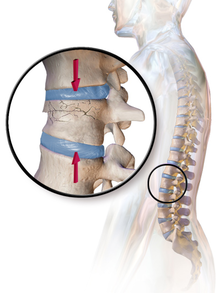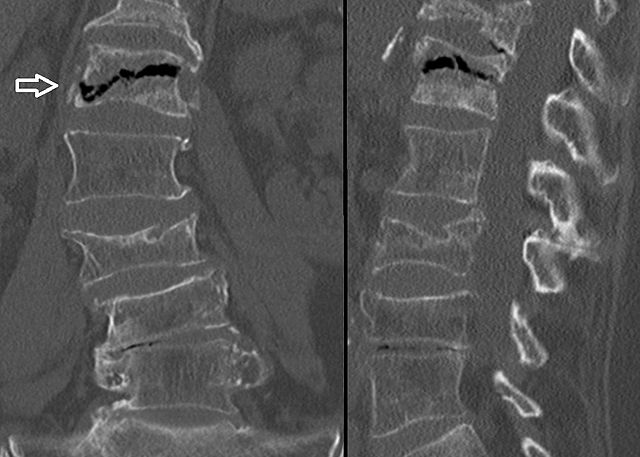Loading AI tools
Breakage of a spinal vertebra under vertical pressure From Wikipedia, the free encyclopedia
A compression fracture is a collapse of a vertebra. It may be due to trauma or due to a weakening of the vertebra (compare with burst fracture). This weakening is seen in patients with osteoporosis or osteogenesis imperfecta, lytic lesions from metastatic or primary tumors,[1] or infection.[2] In healthy patients, it is most often seen in individuals suffering extreme vertical shocks, such as ejecting from an ejection seat. Seen in lateral views in plain x-ray films, compression fractures of the spine characteristically appear as wedge deformities, with greater loss of height anteriorly than posteriorly and intact pedicles in the anteroposterior view.[3]
| Compression fracture | |
|---|---|
 | |
| Example of vertebral compression fracture. | |
| Specialty | Orthopedic |
Acute fractures will cause severe back pain. Compression fractures which develop gradually, such as in osteoporosis, may initially not cause any symptoms, but will later often lead to back pain and loss of height.[citation needed]
Compression fractures are usually diagnosed on spinal radiographs, where a wedge-shaped vertebra may be visible or there may be loss of height of the vertebra. In addition, bone density measurement may be performed to evaluate for osteoporosis. When a tumor is suspected as the underlying cause, or the fracture was caused by severe trauma, CT or MRI scans may be performed.[citation needed]

Seamless Wikipedia browsing. On steroids.
Every time you click a link to Wikipedia, Wiktionary or Wikiquote in your browser's search results, it will show the modern Wikiwand interface.
Wikiwand extension is a five stars, simple, with minimum permission required to keep your browsing private, safe and transparent.